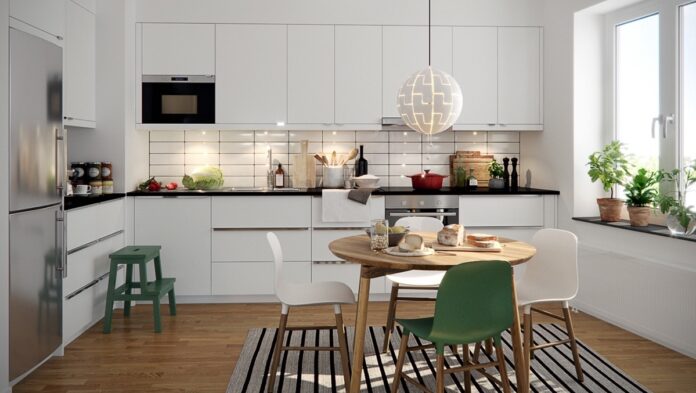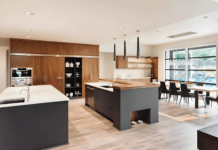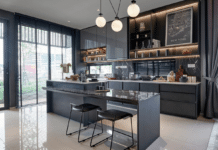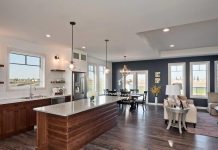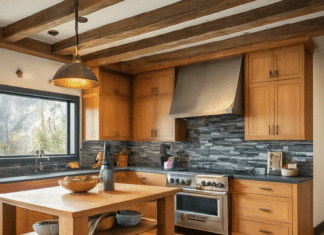The Scandinavian-style kitchen, which has become increasingly popular in recent years, is a well-thought-out minimalist design. Homeowners who value functionality will be drawn to Scandinavian kitchens, as every piece has value.
Clean lines, a neutral color palette, and natural elements like wood characterize this type of kitchen. This type of design is ideal for both small and larger kitchens.
Scandinavian kitchen designs are excellent choices for apartments and townhouses, as the lightness of the space makes the room seem more significant.
What is Scandinavian Kitchen Design
Scandinavian design comes from a Nordic tradition where efficiency and functionality are priorities in the home. This movement has influenced everything from architecture to product design.
This movement occurred in the early 20th century in the Nordic countries of Norway, Sweden, Denmark, and Finland. It became known worldwide in the 1950s and is still popular today.
The Scandinavian design is a solution for simple living that has become popular in contemporary design. The style originally came about as a way to counteract the bleakness of the landscape of Scandinavian countries.
The shorter, dark winter days were balanced by light and bright spaces that capitalize on daylight.
Utility is another important part of this type of kitchen. Furniture is for function, and decorative items are at a minimum.
Architect Mette Aamodt explains, “The modern movement was called ‘Functionalism‘ in Scandinavia, and architecture and design were intended first and foremost to be useful.
Function combined with inspiration from nature creates a warm strain of modernism that is easy to relate to and continues to appeal to many people.”
In this design, less is more, so the kitchen has a limited number of accessories and furnishings. The space is balanced with pieces in relation to one another. A good balance of minimalism creates an open and airy design.
Basic Features of a Scandinavian Kitchen Style
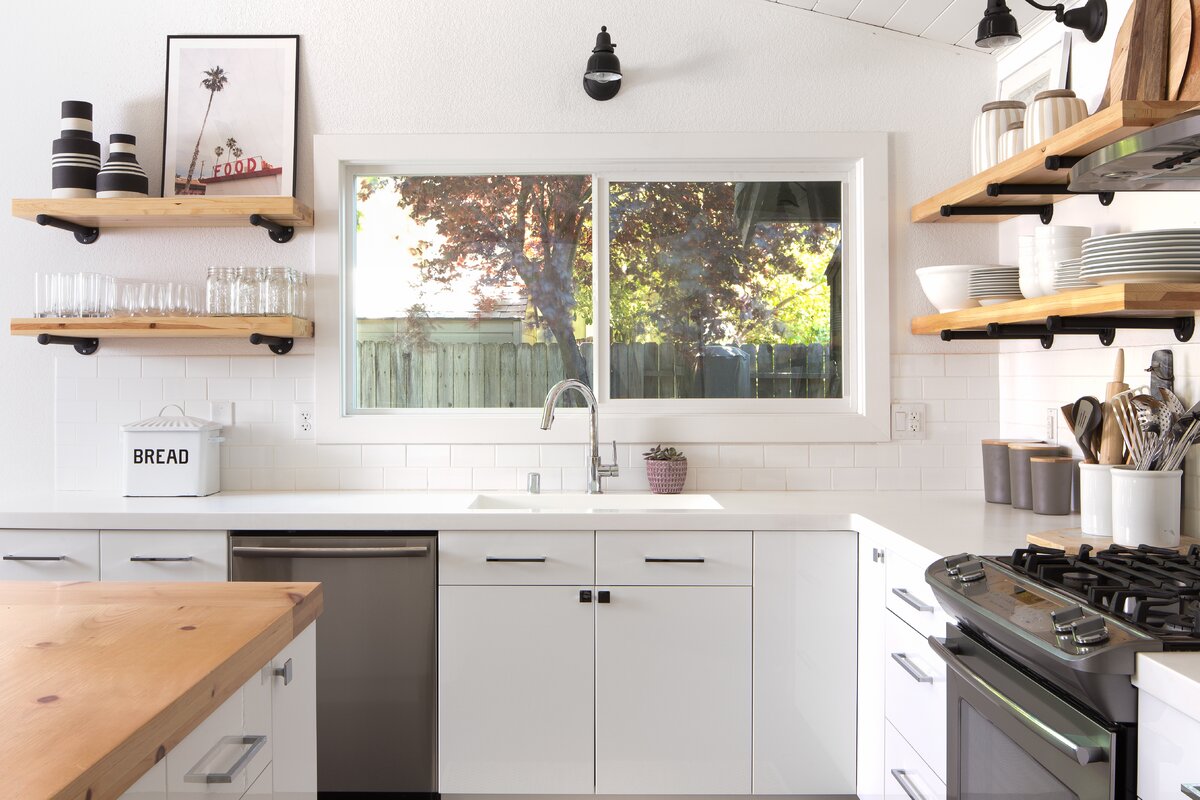
The main elements of this design are simplicity, functionality, and craftsmanship. Most of this style centers around an understated, minimalist aesthetic. Scandinavian design is characterized by the following:
- Clean lines
- Design that follows function
- White-washed finishes
- Clutter-free
- Abundant natural light
- Neutral color palette
- Wood Furniture and Accents
Scandinavian design can work well for homeowners on a budget, as the minimalist look is less expensive than other styles.
Scandinavian-Style Kitchen Cabinets
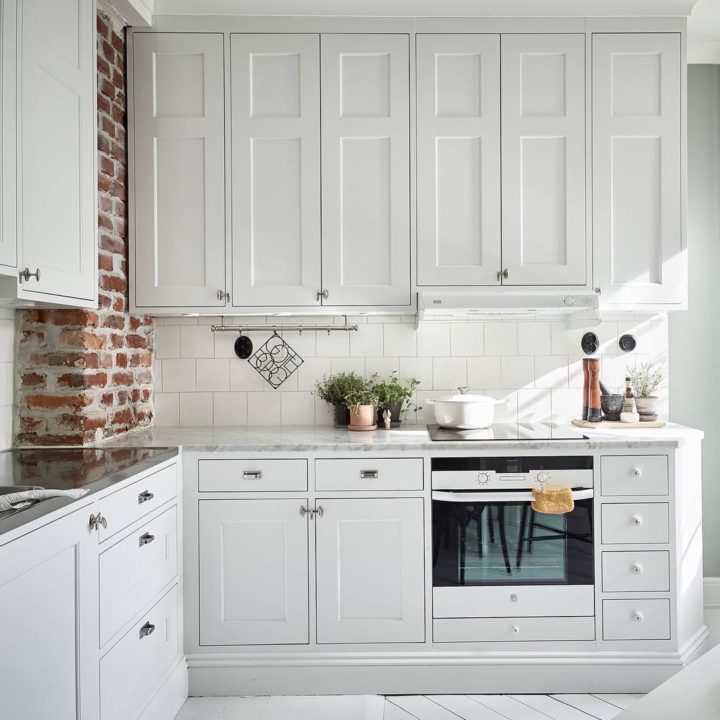
Because cabinets take up a large portion of the space, they must fit the design, be functional, and be light.
The shaker cabinet is a staple in this kitchen style. With a five-piece panel door, this minimalist cabinet has no ornamentation. The clean lines of the shaker style create an understated feel.
The cabinet color is often white or very light-colored to match the rest of the design and add to the space’s lightness. Two-tone cabinets, with white on the upper cabinets and a different color on the bottom, add to the visual interest.
In a larger kitchen, the cabinets can be darker in color as long as there is enough light so that the kitchen does not appear dark.
Hardware is simple yet functional and includes muted finishes such as brass knobs or brushed silver pulls.
Scandinavian-Style Kitchen Backsplash
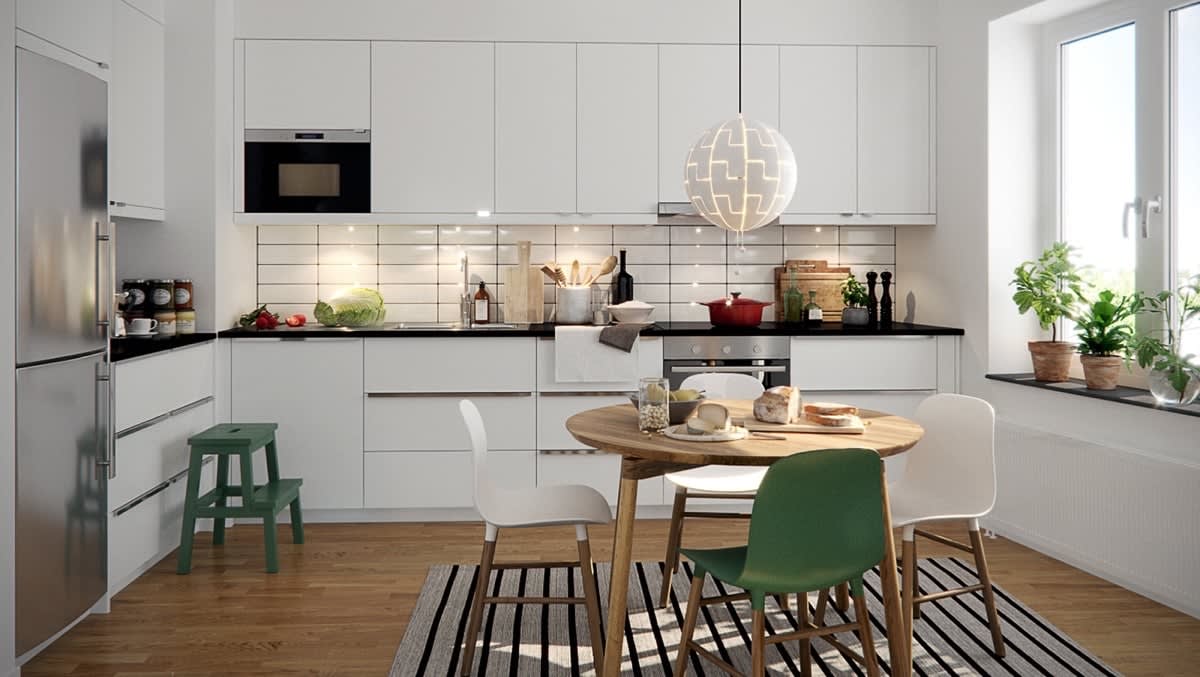
The backsplash can be simple with clean lines or add interest to the room with a pattern. Often, a color scheme of whites, blues, grays, or other neutrals is used.
Natural wood paneling treated with a water-resistant coating adds warmth to the space without being too dark or busy.
A Scandinavian kitchen may feature white backsplashes in a herringbone pattern tile. Another color combination is a light gray tile against white cabinets.
A glass backsplash is sleek and modern, with clean lines. This low-maintenance material offers texture, hue, and size options to match the kitchen color scheme.
Scandinavian-Style Kitchen Countertops
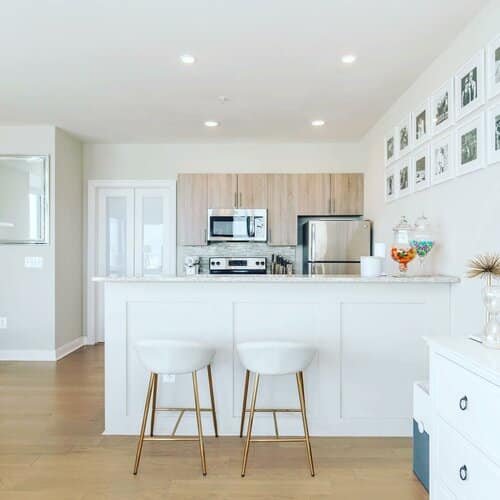
In a Scandinavian kitchen, countertops are streamlined. One option is a wooden butcher block, which is practical for food prep and gives the room a natural feel.
White marble or quartz will match the rest of the room’s color scheme for a monochromatic kitchen and are more modern than butcher block.
However, white or neutral is not the only choice. A black countertop looks sleek in an open-concept kitchen as long as it is paired with lighter cabinets and flooring.
Scandinavian-Style Kitchen Color Palette
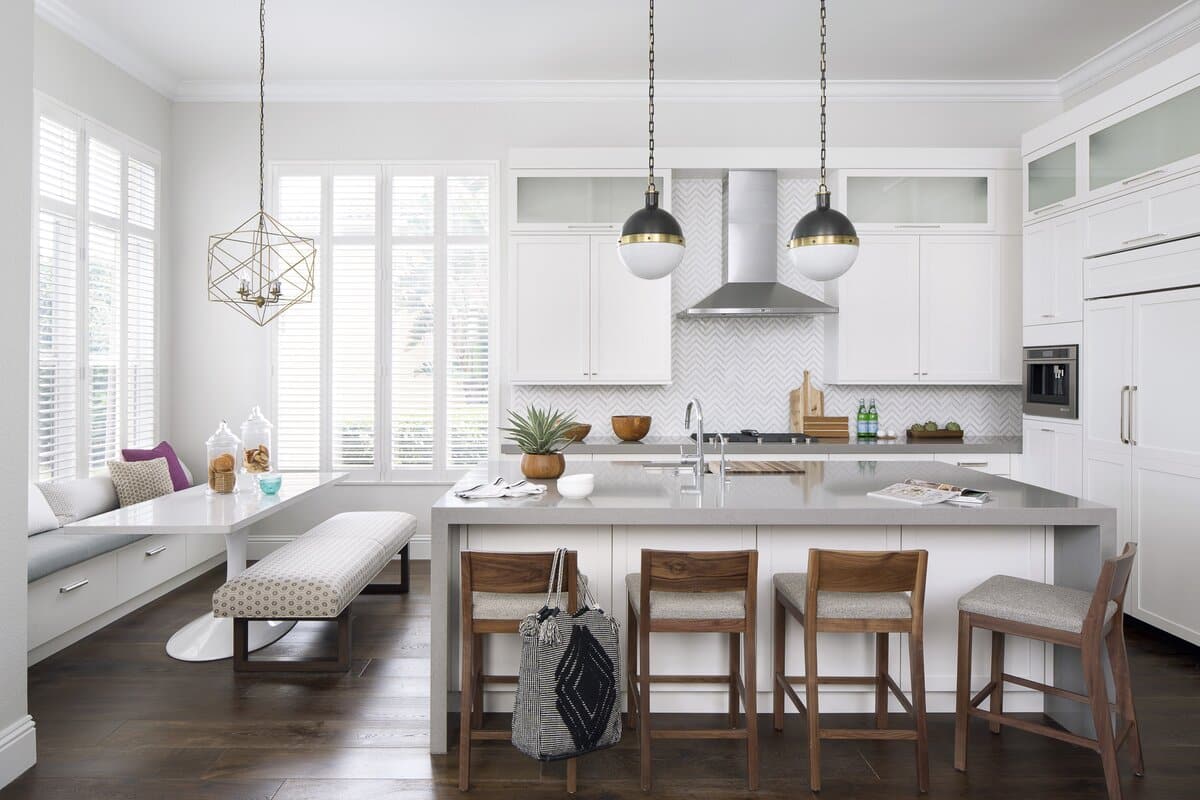
While white kitchens have become popular recently, they have been part of the Scandinavian color scheme for years. The basic color palette for this type of kitchen is neutral and muted shades of whites, dove greys, light blues, and sage greens.
Darker colors, like black, can be used as accent colors to create a bold contrast. Other options are beige, cream, and muted browns, which are usually found in wood flooring and furniture. Many Scandinavian kitchens feature a complete monochrome color scheme.
With a Scandinavian kitchen, white walls, white cabinets, white tiles, and black grouting are an unusual twist. Large windows allow natural light to fill the kitchen, so the overall feel remains open and airy even if some darker accents are used.
Scandinavian-Style Kitchen Texture
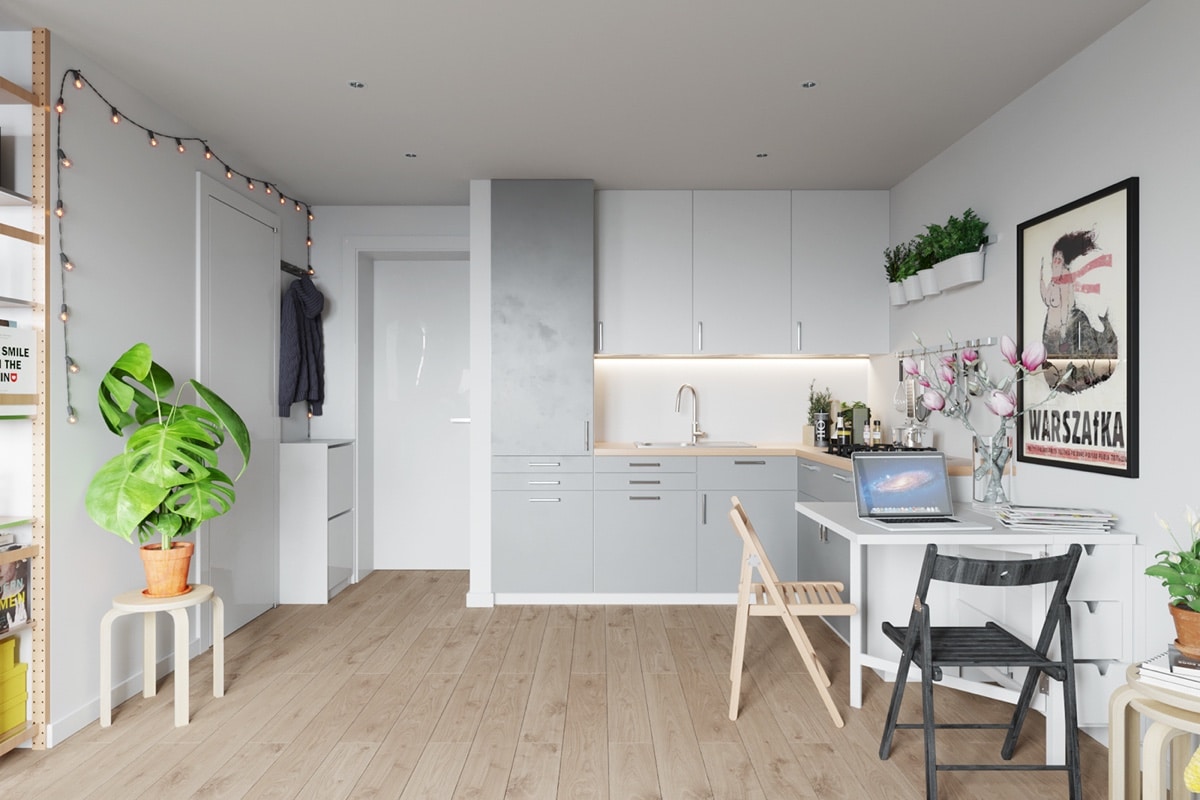
With such a neutral backdrop, the caution with this kitchen style is that it can seem austere. However, there are a few opportunities to add texture to the room. Potted plants or other greenery prevent the space from appearing sterile.
Other natural materials like linen or leather work well with wood surfaces. A hessian rug near the sink introduces texture to keep the space from being boring.
Since this interior design style emphasizes aging, peeling paint or a deteriorating brick wall are focal points. The beauty of the old and decay can sometimes be seen in this type of kitchen. Adding a mix of modern and traditional finishes should appear intentional.
A bright white kitchen with modern white cabinets and stainless steel appliances might showcase a part of the home’s original brick wall. This is a blend of old and new.
Kitchen tools are sometimes on full display in this style, but always in an organized manner. Wooden cutting boards, utensils, and ceramic dishware are shown on counters and open shelving. Wood can be seen in decorative wooden bowls or wooden vases holding branches.
Walls are often white or a neutral color. Wooden beams on the ceiling can create a cozy, Nordic feel. Artwork is used in the kitchen, but minimally.
Several decorative items, like the artwork, are in traditional Nordic patterns that follow Scandinavian design principles.
Scandinavian-Style Kitchen Flooring
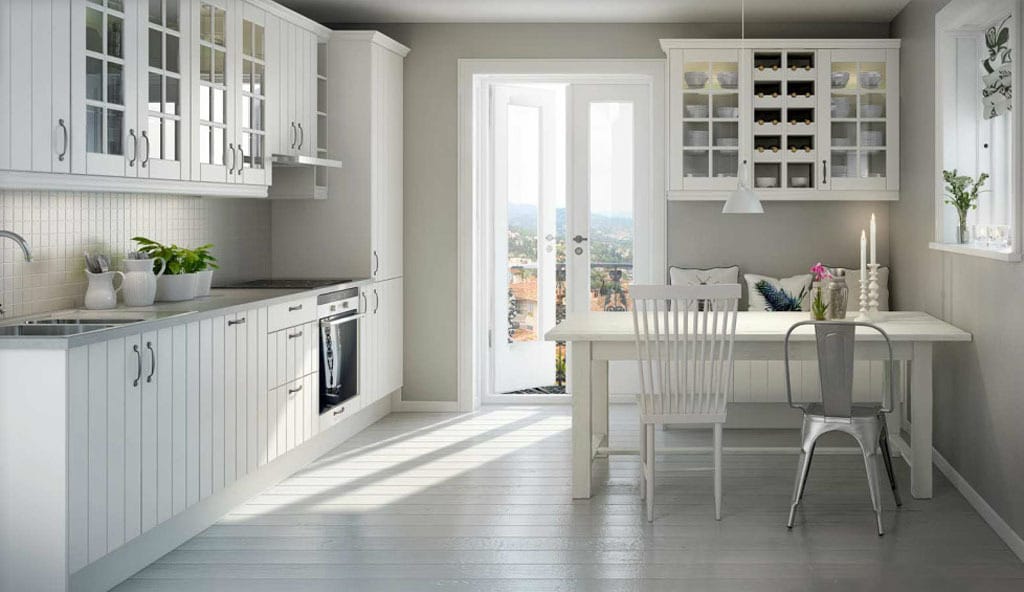
Flooring in Scandinavian kitchens is often made of wood. Scandinavian woods are found in Norway, Finland, Sweden, Denmark, and Iceland. Flooring is usually light in color and matte, such as bleached wood.
Wood has visible grain, various tones, and signs of aging for a natural effect. Wide planks make smaller kitchens look larger, while bigger kitchens cover a lot of space with a low-profile look.
Scandinavian-Style Kitchen Furniture
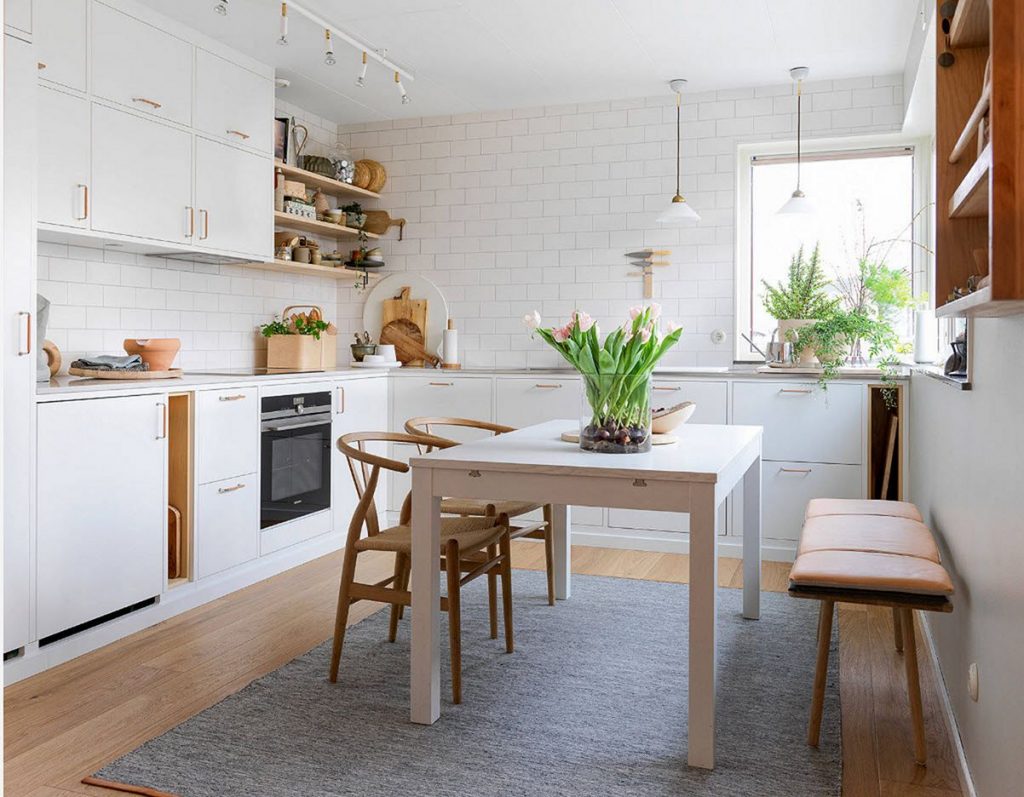
Scandinavian interior design focuses on minimalist, simple, and practical furniture. The function is at the core of furniture design, with the form being almost as important.
Solid wood is often used for furniture like tables and chairs, which feature clean lines. Traditionally crafted items might also be part of the décor.
The furniture can help the overall feeling of the space be either modern or rustic. Woods in lighter colors have a subtle grain and minimal to no knots or dark marks.
In the kitchen, cleverly hidden storage, modular shelving, and flexible designs with the furniture make for a functional space. A big farmhouse-style kitchen in untreated wood can be used in a Scandinavian-style kitchen for a rustic feel.
Scandinavian-Style Kitchen Lighting
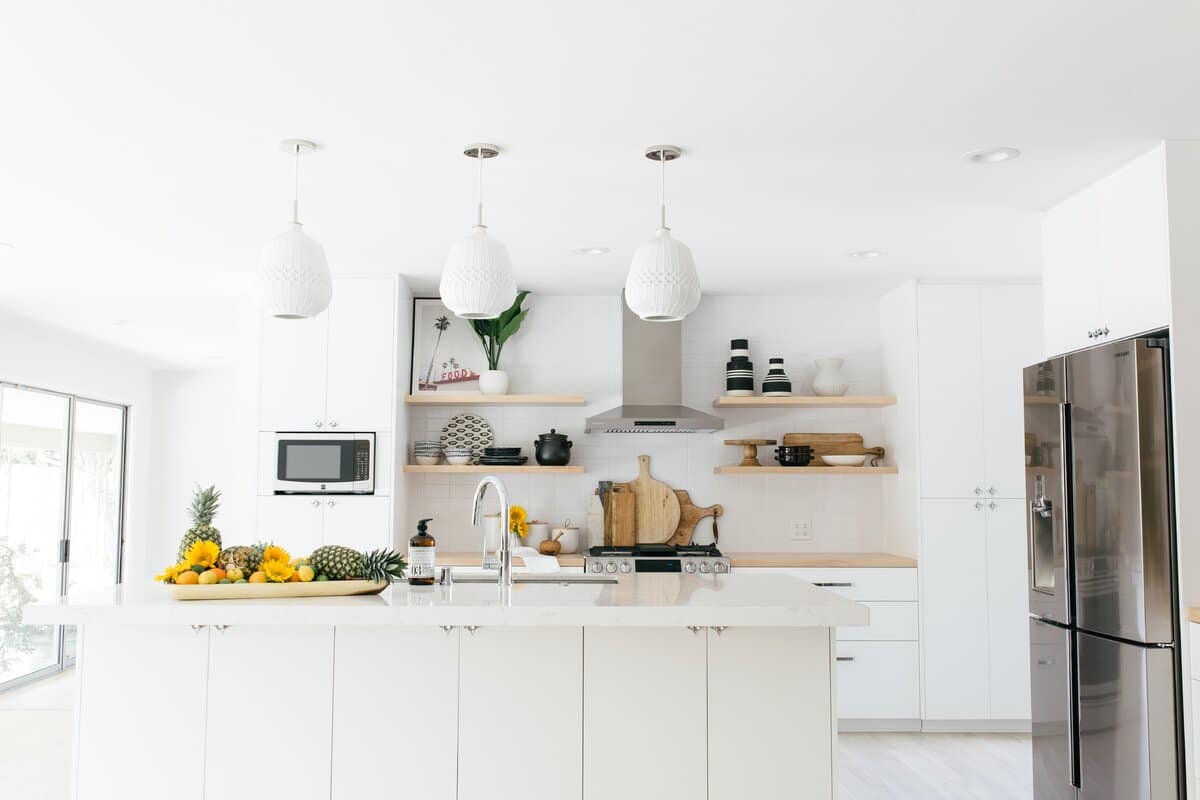
Natural lighting is a key component of this type of kitchen, with many large windows letting in sunlight. The windows are left without adornment to allow as much light as possible.
If privacy is needed, simple wooden roller blinds or gauzy curtains will not take away from the lightness of the room.
Simple pendant lighting is a modern choice for additional lighting that fits the design. Lighting that incorporates a Nordic design can add texture to the space.
Scandinavian Kitchen Sink and Appliances
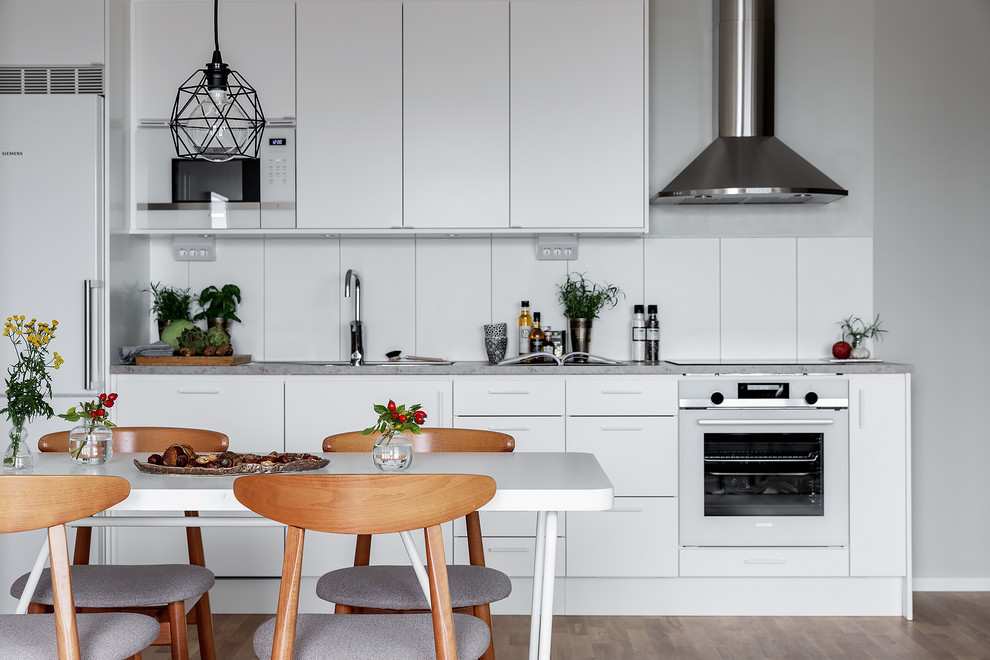
Appliances that blend into the design create a cohesive look. A high-tech smart fridge in stainless steel or matte black that matches the kitchen style will not detract from the rest of the design.
The sink should be simple, keeping with the minimalism of Scandinavian design. A farmhouse stainless steel sink works well in this type of kitchen.
Scandinavian-Style Kitchen Storage
Whether small or large, Scandinavian kitchens maximize space by providing adequate storage. Every element in the kitchen is practical, so the space does not become cluttered.
Since the Scandinavian kitchen is centered on functionality, clever storage solutions allow for kitchen equipment, pots, pans, and other kitchen items.
Wall shelves and floating units keep items off the floor and can house wooden cutting boards and utensils that double as décor. Uncluttered space makes the room appear larger, particularly in smaller kitchens.
Scandinavian Kitchen Trends
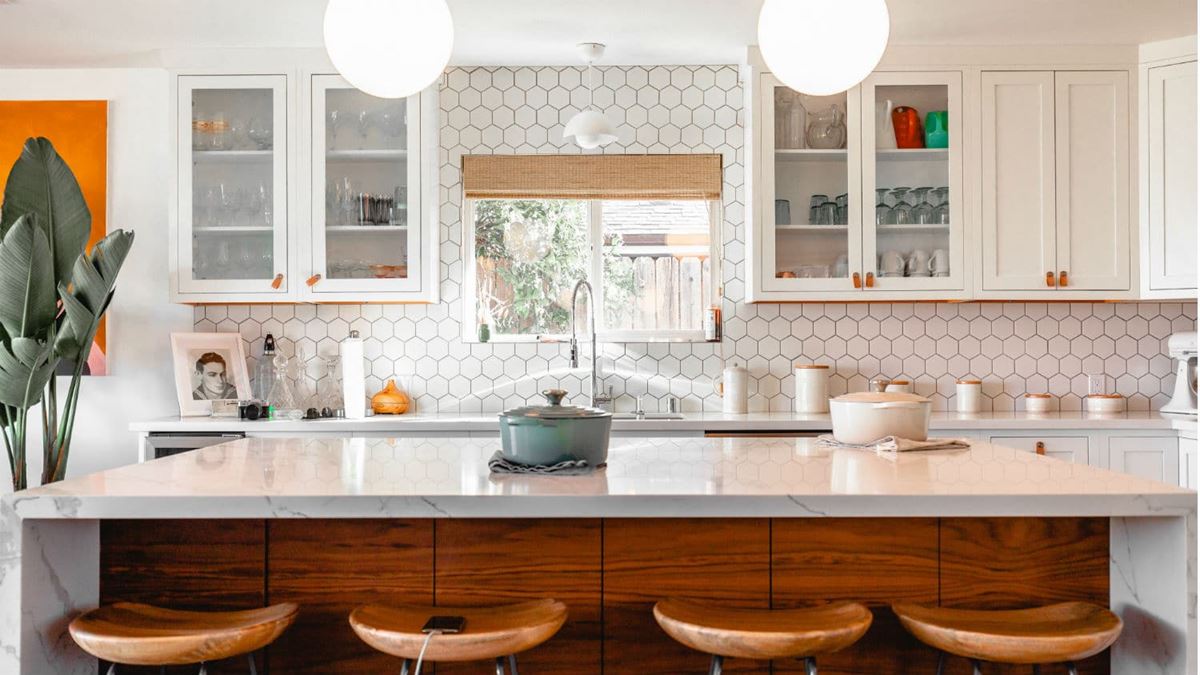
The kitchen island is being used as a multi-purpose station that provides ample counter space for prepping, cooking, and eating. But it also houses a recycling and garbage center, dishwasher, and additional storage room, so it is free from clutter.
Another trend for this year is tall cabinets that go to the ceiling. Glass panels allow for collectibles and other items to be showcased.
While artwork has always been used in Scandinavian kitchens, more items that are usually reserved for living rooms are creeping into kitchens. A small lamp can illuminate the island.
Scandinavian kitchen designs with European cabinets have remained popular for their minimalist and simple style. Homeowners should choose cabinets that are simple to fit in the space.

